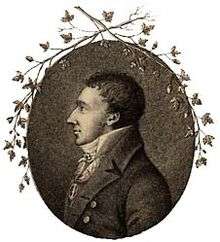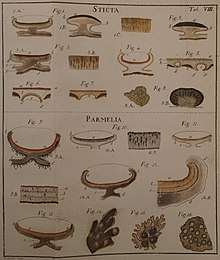Erik Acharius
Erik Acharius (10 October 1757 – 14 August 1819) was a Swedish botanist who pioneered the taxonomy of lichens and is known as the "father of lichenology." Acharius was famously the last pupil of Carl Linnaeus.
Erik Acharius | |
|---|---|
 | |
| Born | 10 October 1757 |
| Died | 14 August 1819 (aged 61) |
| Citizenship | Sweden |
| Alma mater | Uppsala University |
| Known for | Pioneering lichenology |
| Awards | Member of the Linnean Society |
| Scientific career | |
| Fields | Botany Lichenology |
| Academic advisors | Carl Linnaeus |
| Author abbrev. (botany) | Ach. |
Life
Acharius was born in 1757 to Johan Eric Acharius and Catharina Margaretha Hagtorn in Gävle.[1] He received a private education until he was admitted to Gävle Gymnasium in 1770.[1] Later he matriculated at Uppsala University in 1773 where he studied natural history and medicine under Linnaeus and was the last student to defend a dissertation before him.[2] Acharuis's dissertation titled, Planta Aphyteia, was on a vascular plant species collected in Southern Africa by Carl Peter Thunberg, which Linnaeus incorrectly classified as fungi. Thus he is known as "Carl Linnaeus last disciple" or the last pupil of Linnaeus. After graduating from Uppsala in 1776, he later worked for the Royal Academy of Sciences in Stockholm and completed his medical studies at Lund University in 1782.[3] He was appointed town medical officer in Vadstena in 1785, district medical officer in Östergötland County in 1789, director of the new Vadstena Hospital (which he had initiated) in 1795, and titular professor in 1803.[4] As a cartoonist, Acharius Johan illustrated Peter Westring's work Svenska lafvarne color history (1805) and Carl Peter Thunberg's Flora Capensis .
In 1787 Erik Acharuis married Helena Dorotea Scholander (1762 -1804), the daughter of a trader, in Landskrona. After Helena's death Acharuis married Margareta Maria Hoffberg on December 31, 1804. She was the daughter of Gottfrid Hoffberg who was in charge of production of saltpeter for munitions in Skänninge.[1] In total Erik Acharuis had four children, Lars Gustaf Acharius, Jean Torkel Acharius, Catharina Theodora Ohrling (née Acharuis) and Charlotta Wilhelmina Acharuis.[5]
Acharius spent the remainder of his life in Vadstena, where he died of a stroke while in his household garden examining a Spanish collection of lichens on 14 August 1819, at the age of 61.[2]
Work in lichenology

Acharius belonged to the younger generations of Swedish botanists who continued what Linnaeus had left undone; classifying all living organisms. Acharius began the taxonomic classification of Lichenes and during his lifetime he classified over 3300 species of lichen separated into 40 different genera.[6] At the time of Linnaeus's death all lichens were grouped into a single genus, thus Acharius was the first to expand lichen classification into the multi-divisional group of organisms it is known to be today.[7] His first publication was Lichenographiae Suecia prodromus, published in 1798, which detailed all known lichen species found in Sweden. This was the first published work to detail lichens using binomial nomenclature and expand their classification beyond a single genus. While composing Lichenographiae Suecia prodromus, Acharuis began communicating with Olof Swartz, another Linnaean disciple, and from 1780 to 1815 they sent nearly 350 letters to each other.[2] Swartz is believed by many historians to have heavily influenced the development of Acharuis's classification system.[8] Additionally, Swartz introduced Acharuis to many other Swedish naturalists as also several important international figures such as James Edward Smith, the head of the Linnean Society. This exposure aided Acharuis in spreading his new findings on lichens to an international audience. After publishing his first work, he sent a copy to James Edward Smith who, in response, inducted Acharuis as a foreign member of the Linnean Society.[9] Subsequently, Acharuis published Methodus qua omnes detectos Lichenes (1803),[10] Lichenographia universalis (1810),[11] and Synopsis methodica lichenum (1814)[12] each of which he sent to the Society in London, accompanied by hundreds of the specimens described in each book.[13] Over his lifetime Acharius collected over 5500 specimens of lichen most of which are housed today in the Botanical Museum of the Finnish Museum of Natural History.[14]
Legacy
Acharuis's international reputation influence many new lichenologist from all over Europe. In 1804 Friedrich Weber (1781-1823) and Daniel Matthias Heinrich Mohr (1780-1808), two German naturalists, published Naturhistorische Reise durch einen Theil Schwedens which heavily featured his work on lichens and also included four illustrations by Acharuis.[15] Furthermore, William Borrer who pioneered lichenology in Britain (and is often called the father of British lichenology) was heavily influence by Acharius's specimens and publications received by the Linnean society in London. These collections and books were studied by Borrer in 1809 and served as the basis for his own work.[2] Additionally Thomas Gage published A Monograph of the Genus Cenomyce: Consisting of Coloured Drawings of Each Species and Variety, As Described in the Lichenographia Universalis of Acharius in 1815, which contained illustrations of every species and variation of the genus Cenomyce as described in Lichenographia Universalis[16]. To this day several of Acharuis's original classification schema are still used in lichen taxonomy.[17]
Publications and honors

He was a member of the Royal Physiographic Society in Lund (1795), the Royal Swedish Academy of Sciences (1796), the Linnean Society of London (1801), appointed Knight of the Vasa (1809), and Order and the Royal Society of Sciences in Uppsala (1810).
The plant genus Acharia, several plants species (e.g., Rosa acharii and Conferva acharii), and one insect, Tortrix achariana have all been named after Acharius; likewise, the Acharius Medal is awarded for lifetime achievement in lichenology.
The collections of Acharius are distributed over several museums: the Finnish Museum of Natural History in Helsinki, which holds the Botanical Museum in Uppsala, the Swedish Museum of Natural History and the Botanical Museum in Lund. His papers are in the Library of Uppsala University.[14] There are also specimens that he collected in the Natural History Museum, London.[18]
The following is a list of Erik Acharuis's publications
Lichenographiae svecicae Prodromus (Beginning of a Lichenography of Sweden) 1798[19]
Methodus qua omnes detectos Lichenes (A Method by which Everyone Can Identify Lichens) 1803[20]
Lichenographia universalis (A Universal Lichenography) 1810[11]
Synopsis methodica Lichenum (Taxonomical Arrangement of Lichens) 1814[12]
See also
References
- Sernander., K. “Erik Acharius - Svenskt Biografiskt Lexikon.” Fredrik Teodor Borg - Svenskt Biografiskt Lexikon, sok.riksarkivet.se/sbl/Presentation.aspx?id=5503.
- Thell, A., Kärnefelt, I., Seaward, M., & Westberg, M. (Eds.) (2013). In the footsteps of Erik Acharius. 20th biennial meeting of the Nordic Lichen Society. Vadstena 11–15 August 2013. Programme and Abstracts. Nordic Lichen Society.
- Hofberg, Herman, et al. “Acharius, Erik (Svenskt Biografiskt Handlexikon).” Acharius, Erik, Project Runeberg, 24 Mar. 1997, runeberg.org/sbh/achareri.html.
- “Erik Acharius.” The Mushroom Journal, www.mushroomthejournal.com/greatlakesdata/Authors/Acharius601.html.
- “Erik Acharius.” Ilse Luise Ledermann-Citroen - Biographical Summaries of Notable People - MyHeritage, MyHeritage, www.myheritage.com/names/erik_acharius.
- Anderberg, Arne. “Erik Acharius, the Father of Lichenology.” Naturhistoriska Riksmuseet - Startsida, Naturhistoriska Riksmuseet, 7 Nov. 2014, www.nrm.se/en/forskningochsamlingar/botanik/botaniskhistoria/erikacharius.310.html.
- Frödén, Patrik. “Lichenology in Lund – an Historical Overview | The Lichenologist.” Cambridge Core, Cambridge University Press, 6 Aug. 2009, www.cambridge.org/core/journals/lichenologist/article/lichenology-in-lund-an-historical-overview/12AD4A9CCFD0292CC73E7C3A17B8964D.
- “Erik Acharius, Olof Swartz and the Evolution of Generic Concepts in Lichenology | Archives of Natural History.” International Journal of Humanities and Arts Computing, www.euppublishing.com/doi/pdfplus/10.3366/anh.1981.017.
- “Acharius' Lichenographiæ Sueciæ Prodromus.” Uppsala University Library, Uppsala University, Sweden, www.ub.uu.se/finding-your-way-in-the-collections/selections-of-special-items-and-collections/acharius/.
- Acharius, Erik. Synopsis Methodica Lichenum. 1814
- Acharius, Erik. Lichenographia Universalis: In Qua Lichenes Omnes Detectos, Adiectis Observationibus Et Figuris Horum Vegetabilium Naturam Et Organorum Carpomorphorum Structuram Illustrantibus, Ad Genera, Species. Gottingae: Apud I. F. Danckwerts, 1810.
- Acharius, Erik. Synopsis Methodica Lichenum. 1814.
- “The Linnean Collections.” Correspondence from Acharius, Erik to Smith, Sir James Edward - The Linnean Collections, The Linnean Society, 7 Mar. 2016, linnean-online.org/view/correspondence_by_collection/smith=5Fcorrespondence/Acharius=3AErik=3A=3A/Smith=3A_Sir_James_Edward=3A=3A.html.
- Laine, Sanna. “Erik Acharius Lichen Collection.” GBIF, Finnish Museum of Natural History , 8 Jan. 2014, www.gbif.org/dataset/6c781d5f-a189-497b-a78d-5c2d7b41cb6a#description.
- Weber, Fried, and Dan Matth. Heinr. Mohr. Naturhistorische Reise Durch Einen Theil Schwedens. 1804.
- Gage, Thomas, University of Chicago. Library. Crerar Ms. 132, and Crerar Manuscript Collection (University of Chicago. Library). A Monograph of the Genus Cenomyce: Consisting of Coloured Drawings of Each Species and Variety, As Described in the Lichenographia Universalis of Acharius. 1815.
- Kärnefelt, and Frödén. “Erik Acharius - the Last of the Linnean Pupils.” Spa and Wellness- Are There Environmental Challenges?, Elsevier Limited, 1 Jan. 1970, lup.lub.lu.se/search/publication/744421
- "Lichen collections". Natural History Museum. Retrieved 14 January 2020.
- Acharius, Erik. Lichenographiae Svecicae Prodromus. Lincopiae: D. G. Björn, 1798.
- Acharius, Erik. Methodus Qua Omnes Detectos Lichenes: Secundum Organa Carpomorpha, Ad Genera, Species Et Varietates. Stockholmiae: impensis F.D.D. Ulrich, typis C.F. Marquard, 1803.
- IPNI. Ach.
- Nordisk familjebok, vol. 1 (1904), col 96
- Monika Myrdal: "Erik Acharius, the father of lichenology", at , the website of the Swedish Museum of Natural History. With links to sample images of his publications.
- Rutger Sernander: "Acharius, Erik", Svenskt biografiskt lexikon, vol. 1, pp. 28–80.
Further reading
- Eriksson, Gunnar (1970). "Acharius, Erik". Dictionary of Scientific Biography. 1. New York: Charles Scribner's Sons. pp. 45–46. ISBN 0-684-10114-9.